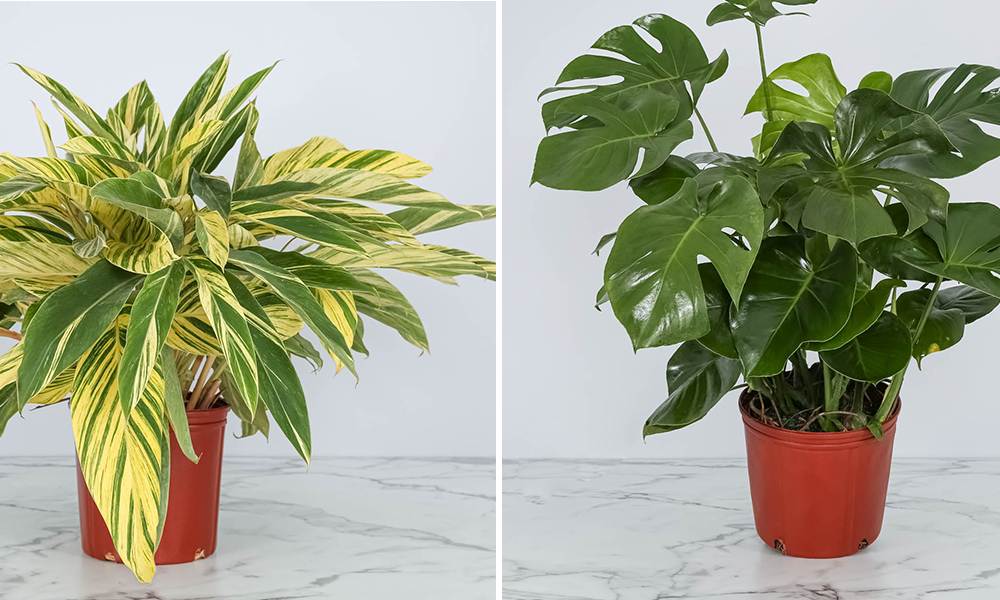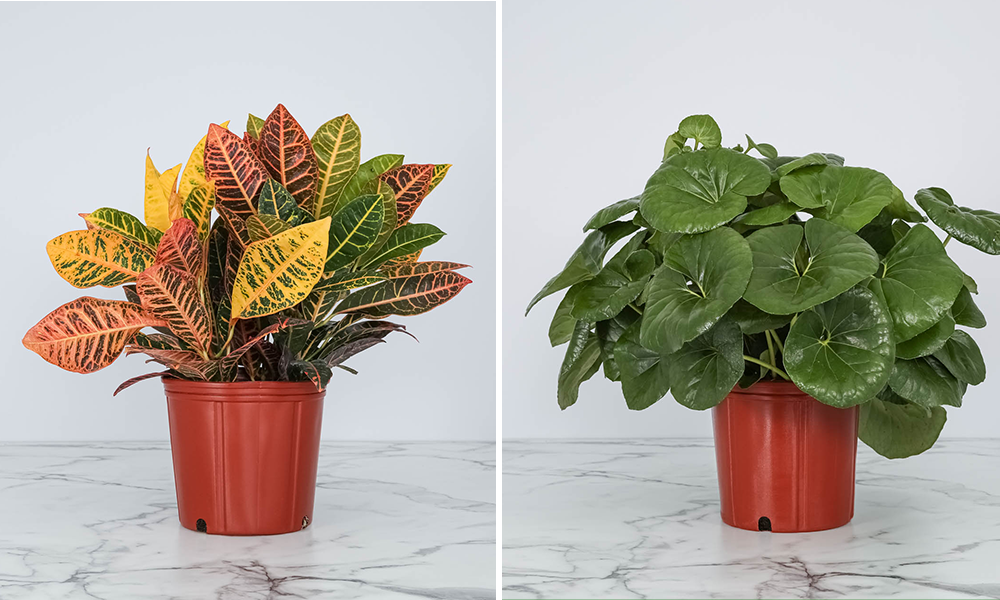It’s no secret that we’re obsessed with tropicals, and why wouldn’t we be? The lush greenery, unique shapes, and colorful blooms of these bold beauties complete the look of any home decor scheme. Since we work with these exotic plants every day, we can’t help but pick favorites! We’ve chosen the best of the best based on great color, eye-catching shapes, versatility, and ease of care. Here are our top 8 tropical plants for 2020.
1. Variegated Ginger
Eye-catching is an understatement for this beauty! The spectacular green and chartreuse foliage of this subtropical plant creates an instant “wow” effect, whether you keep it in a pot or planted in your garden bed. While the foliage is its star feature, this fancy plant also produces clusters of nodding white flowers that resemble small seashells. In case you were wondering, variegated ginger is, indeed, related to the fragrant root you mince into your recipes. The rhizomes of variegated ginger smell just like those of its culinary cousin—but with a plant this pretty, we wouldn’t dare try to eat it!
Top Care Tips: To care for variegated ginger, plant outdoors in a location with full sun exposure. Variegated ginger loves the humidity, so a location near a water feature suits it just fine! This plant favors rich, moist soil with plenty of organic matter. When planting in beds, enrich the soil with high-quality compost at the time of planting. Variegated ginger kept in pots should be fertilized monthly.

2. Bird of Paradise
If you’re not already familiar with Bird of Paradise, its name suits it perfectly. These majestic plants bear a highly unique-looking flower with vibrant orange and blue bracts that resemble an exotic bird in flight. If you’re looking to create a getaway-like atmosphere with your landscape design, Bird of Paradise is, without a doubt, among the best outdoor tropical plants you can add to your garden. Plus, their signature blooms make incredible cut flowers!
Top Care Tips: To care for Bird of Paradise, plant in acidic soil with full sun exposure. If your soil is neutral to alkaline, enrich the area with peat. Bird of Paradise should be watered frequently for several weeks to help the roots establish. After about a month, you can reduce the watering schedule. In the spring and summer months, the plant will need to be fed bi-weekly with a water-soluble all-purpose fertilizer. Start fertilizing in the spring just before new growth appears.
3. Monstera Deliciosa
We’d be shocked if you aren’t already in love with this trendy plant, which is also known by the common name, Swiss cheese plant! The instantly-recognizable split leaves of the monstera have been showing up everywhere; on clothing, in art prints, and on the cover of every home decor magazine. Monstera leaves have captured the attention of “plant parents” everywhere, and the trend doesn’t seem to be going anywhere as we move into 2020! A word of warning for those eager to get their hands on one: monstera leaf takes a while to develop its signature splits and holes, which appear over time as it matures.
Top Care Tips: To care for monstera deliciosa, allow the first inch of soil to dry out between waterings. Outdoors, monstera does well in a location with dappled shade and tends to spread and climb, making them ideal trellis plants. When kept indoors, monstera thrive next to a window with sheer drapes where their extraordinary foliage can soak up plenty of filtered sunshine—and attention from guests!

4. Majesty Palm
As their name suggests, majesty palm has regal, arching foliage with fine-textured, draping fronds. This plant makes an exotic accent for empty corners in living or dining rooms and patios. The mere sight of the majesty palm is enough to transport the imagination to the beaches of Bali or the jungles of Madagascar.
Top Care Tips: To care for majesty palm, sunlight is key. Choose the brightest location possible for this sun-loving plant, and prune off fronds that have begun to yellow or brown to encourage healthy growth. Native to subtropical forest environments, the soil of the majesty palm should be kept evenly moist and fronds should be kept in high humidity or misted daily. Fertilize your majesty palm every few months during the spring and summer, while the plant is growing most actively. More care tips for palm trees here.
5. Triostar Stromanthe
It’s not every day that you see a tropical plant that looks in-season whether it’s July 1st or December 25th! This stromanthe features a vibrant candy-cane color palette of white, red, and green foliage. As a shade-loving plant, triostar stromanthe can be planted outdoors in a covered location or just about anywhere indoors.
Top Care Tips: To care for your stromanthe, keep it in a high-humidity environment. To boost humidity near the plant without increasing the humidity throughout your home, place the pot on a saucer covered with a layer of pebbles and pour enough water onto the saucer to nearly cover the pebbles. The pebbles will prevent the plant from sitting in the water, but the water will increase humidity around the plant as it evaporates. Meanwhile, allow the first inch of the soil to dry out between waterings and fertilize your stromanthe monthly during the spring and summer.

6. Mammy Croton
While some croton varieties are known for being some of the best tall tropical plants for privacy with their impressive height, Mammy is a more compact variety that is versatile enough to be grown as a houseplant or as a landscape feature. Crotons are well-known for their exceptionally colorful foliage in shades of mango, banana-yellow, and jewel-toned greens and reds.
Top Care Tips: To care for Mammy croton, keep yours in a bright location. The plant needs ample sun to maintain its vibrancy. Crotons should be kept in moist soil in a humid area, though they aren’t particular about soil type. Fertilize your croton three times per year; in spring, summer, and fall.
7. Tractor Seat Farfugium
While the name “tractor seat” brings to mind the farming culture of the Midwest, make no mistake—this plant is as tropical as they come! Their leaves, which have a shape and texture like the leather seat of a tractor, absolutely adore humidity and moisture. In the landscape, they look right at home near the edges of ponds and waterfall features. Indoors, they make a statement in bathrooms with a bright window.
Top Care Tips: To care for tractor seat farfugium, your first priority is to keep the soil evenly moist. Use a peat-based soil blend with excellent drainage to keep it moist without becoming waterlogged. Farfugium thrives best in a location with morning sunlight and afternoon shade.

8. Alocasia Borneo
If there’s any plant on this list that would be pretty difficult to keep indoors, it’s this one! Alocasia borneo is also known as “giant elephant ear”, and if you’ve ever seen the standard elephant ear varieties, it’s immediately apparent what makes this one so different. Alocasia borneo can reach towering heights up to 7 feet tall, with a spread up to 6 feet across—a great choice if you love a plant that makes you feel tiny by comparison!
Top Care Tips: For indoor care for alocasia borneo, plant in soil with good drainage, which should be kept evenly moist. To improve drainage, add peat, perlite, and sphagnum moss to the soil mixture. This plant is a great candidate for drip irrigation systems due to its size and moisture needs. Fertilize every third week during the growing season with a balanced, 20-20-20 fertilizer.
Ready to turn your home into a tropical oasis? Shop our tropicals now to start your wishlist and get your favorites shipped right to your door—starting Cyber Monday!

